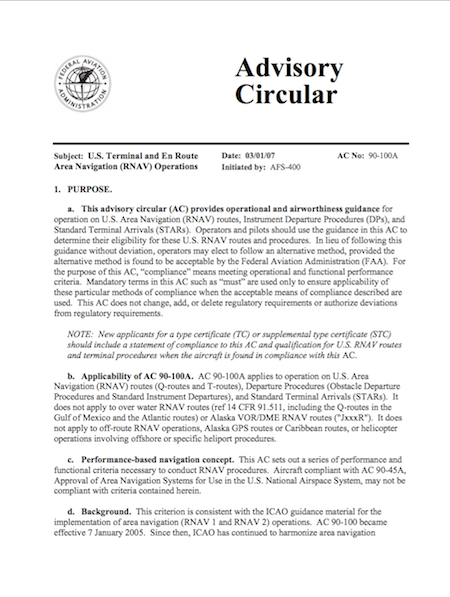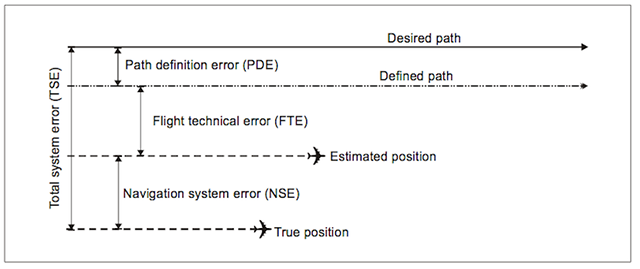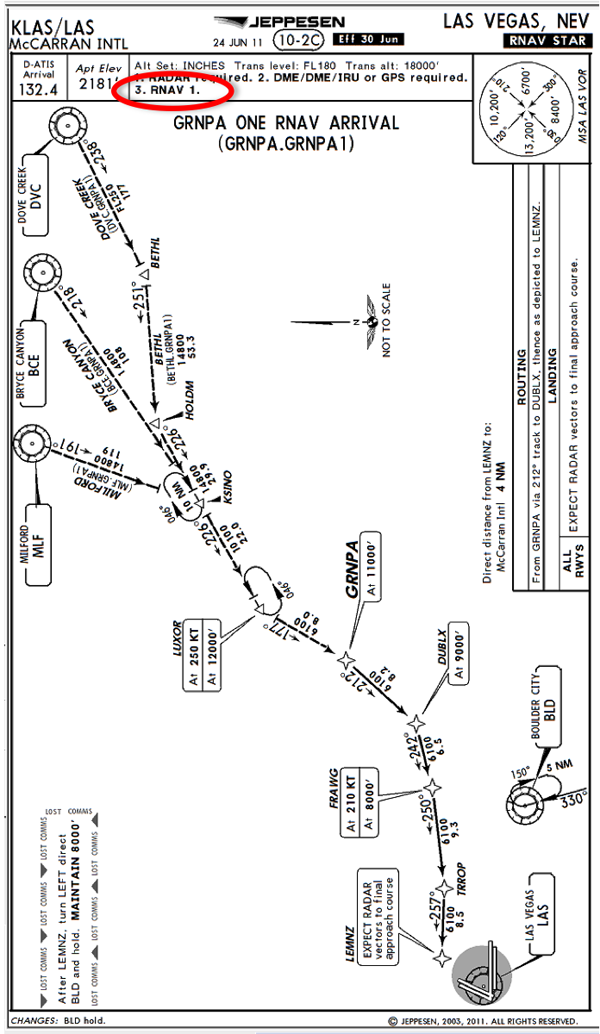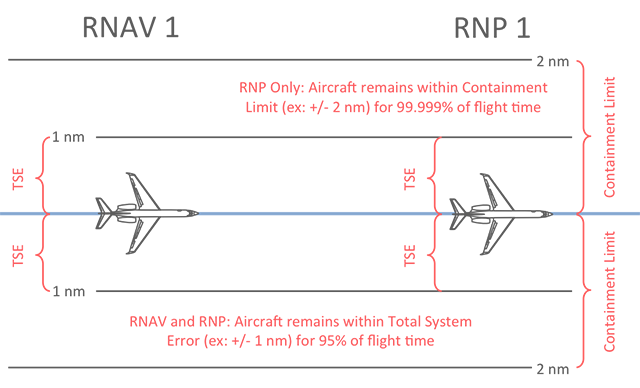So what is the difference between area navigation (RNAV) and required navigation performance (RNP)? Well that depends...
— James Albright

Updated:
2020-12-10
RNAV airspace generally mandates a certain level of equipment and assumes you have a 95% chance of keeping to a stated level of navigation accuracy. RNP is a part of Performance Based Navigation (PBN) which adds to the same RNAV accuracy standards a level of system monitoring and alerting. But not always! It has made the various navigation rules easier to understand, but it hasn't made them easily understood. It can be confusing . . .

1
The big picture

AC 90-100A Cover, from AC 90-100A
Area Navigation (RNAV). A method of navigation which permits aircraft operation on any desired flight path within the coverage of station-referenced navigation aids or within the limits of the capability of self-contained aids, or a combination of these. For the purposes of this AC, the specified RNAV accuracy must be met 95% of the flight time.
Source: AC 90-100A, ¶4.b
RNAV systems evolved in a manner similar to conventional ground-based routes and procedures. A specific RNAV system was identified and its performance was evaluated through a combination of analysis and flight testing. For domestic operations, the initial systems used very high frequency omnidirectional radio range (VOR) and distance measuring equipment (DME) for estimating their position; for oceanic operations, inertial navigation systems (INS) were employed. These "new" systems were developed, evaluated and certified. Airspace and obstacle clearance criteria were developed based on the performance of available equipment; and specifications for requirements were based on available capabilities. In some cases, it was necessary to identify the individual models of equipment that could be operated within the airspace concerned. Such prescriptive requirements resulted in delays to the introduction of new RNAV system capabilities and higher costs for maintaining appropriate certification.
Source: ICAO Doc 9613, pg. I-(iii)
In the old days we would navigate IFR from navaid to navaid and when we had to, we would fly fix-to-fix by mentally visualizing the airspace and estimating a course to fly. How? See: Fix-to-fix.
Then various boxes appeared that did this better than we could and "area navigation" was born. It is simply a method of navigation that allows us to fly along any desired flight path. Inertial navigation systems allowed us to do this beyond the range of navigation aids and GNSS / GPS give us access to the best navigation aid of all just about anywhere in the world.
RNP

ICAO Doc 9613 Cover, (ICAO Doc 9613
Performance-based navigation (PBN). The PBN concept specifies that aircraft RNAV system performance requirements be defined in terms of the accuracy, integrity, availability, continuity and functionality, which are needed for the proposed operations in the context of a particular airspace concept. The PBN concept represents a shift from sensor-based to performance-based navigation. Performance requirements are identified in navigation specifications, which also identify the choice of navigation sensors and equipment that may be used to meet the performance requirements. These navigation specifications are defined at a sufficient level of detail to facilitate global harmonization by providing specific implementation guidance for States and operators.
Under PBN, generic navigation requirements are defined based on operational requirements. Operators then evaluate options in respect of available technology and navigation services, which could allow the requirements to be met. An operator thereby has the opportunity to select a more cost-effective option, rather than a solution being imposed as part of the operational requirements. Technology can evolve over time without requiring the operation itself to be reviewed, as long as the expected performance is provided by the RNAV system. As part of the future work of ICAO, it is anticipated that other means for meeting the requirements of the navigation specifications will be evaluated and may be included in the applicable navigation specifications, as appropriate.
Source: ICAO Doc 9613, pg. I-(iii)
Performance based navigation incorporates RNAV and adds the ability to continuously monitor the accuracy and utility of the system, alerting the pilot when the system isn't as good as it is supposed to be.
RNAV vs. RNP
Not to long ago the terms RNP and RNAV were used interchangeably. The Performance Based Navigation (PBN) concept changed all that. In concept, RNAV is a subset of RNP. In actual practice, there is an exception given for RNP-10, which is actually another form of RNAV. (More on that below.)
2
Equipment Requirements
RNAV
RNAV routes typically specify minimum equipment levels needed to satisfy navigation accuracy. For example:
U.S. RNAV operations are based upon the use of RNAV equipment that automatically determines aircraft position in the horizontal plane using inputs from the following types of positioning sensors (no specific priority).
(1) Global Navigation Satellite System (GNSS) in accordance with TSO-C145a, TSO- C146a, and TSO-C129/C129a. Positioning data from other types of navigation sensors may be integrated with the GNSS data provided it does not cause position errors exceeding the total system error requirements. The use of GPS equipment approved to TSO-C129() is limited to those which include the minimum system functions specified in Appendix 3. As a minimum, integrity should be provided by ABAS. In addition, GPS stand-alone equipment should include the following additional functions:
- Pseudorange step detection
- Health word checking.
For procedures requiring GPS and/or aircraft approvals requiring GPS, if the navigation system does not automatically alert the flight crew of a loss of GPS, the operator must develop procedures to verify correct GPS operation.
(2) DME/DME RNAV equipment complying with the criteria in appendix 1. Based on current DME availability evaluations, coverage is not sufficient to support DME/DME RNAV operations without additional IRU augmentation or using GPS.
(3) DME/DME/IRU RNAV equipment complying with the criteria in appendix 2.
Source: AC 90-100A, ¶8.b.
RNP
True RNP, that using Performance Based Navigation, does not specify equipment but may require more than just navigation capability:
PBN offers a number of advantages over the sensor-specific method of developing airspace and obstacle clearance criteria, i.e.:
- reduces the need to maintain sensor-specific routes and procedures, and their associated costs;
- avoids the need for developing sensor-specific operations with each new evolution of navigation systems, which would be cost-prohibitive;
- allows for more efficient use of airspace (route placement, fuel efficiency and noise abatement);
- clarifies how RNAV systems are used; and
- facilitates the operational approval process for operators by providing a limited set of navigation specifications intended for global use.
Within an airspace concept, PBN requirements will be affected by the communication, surveillance and ATM environments, the navaid infrastructure, and the functional and operational capabilities needed to meet the ATM application. PBN performance requirements also depend on what reversionary, non-RNAV means of navigation are available and what degree of redundancy is required to ensure adequate continuity of functions.
Source: ICAO Doc 9613, page I-(iii)
Monitoring Ground-based NAVAIDS
The pilot is not required to monitor ground-based NAVAIDs used in position updating unless specified by the Airplane Flight Manual (AFM).
Source: AC 90-105A, ¶6.3
3
Total System Error (TSE)

Lateral navigation errors, (ICAO Doc 9613, figure II-A-2-1)
Total System Error (TSE) is simply a measure of how far off course the airplane can be. In RNP-1 or RNAV-1 airspace, for example, the TSE = 1. Is RNP more accurate than RNAV? No.
- RNAV systems conform to the ICAO performance-based navigation specification for total system error (TSE). RNAV total system error is the 95% probability that the navigation system accuracy remains within the limits defined for the RNAV operation. For example, during an RNAV-1 operation the TSE remains within one nautical mile of the desired path 95% of the time.
- RNP systems conform to a performance-based navigation specification based on RNAV capability that also includes requirements for on-board performance monitoring and alerting. For example, during an RNP 1.0 operation, the TSE remains within one nautical mile of the desired path 95% of the time, and on-board performance monitoring provides the pilot with an alert when the probability that TSE exceeds 2xRNP is greater than 10-5.
- RNP is an RNAV subset that also includes a requirement to provide on-board navigation system accuracy performance monitoring and alerting which means an RNP system is also an RNAV system. GNSS equipment provides accuracy performance monitoring and alerting which, by definition, makes it both an RNAV and RNP capable system.
Source: AC 20-138D, ¶1-4.g.(2)
Looking at the figure on the top of the page, you see that both RNAV-1 and RNP-1 keep the aircraft within 1 nautical mile of centerline 95% of the flight time. The difference is that under RNP-1, the pilot is notified when the system thinks there is a greater than 0.00001 probability (.001%) that the airplane could wander outside of 2 nautical miles.
- RNAV says you should be on course,
- RNP says you should be on course, monitors system performance, and alerts you when it thinks there is a problem.
4
Containment
So what makes RNP different than RNAV?
Let's first look at what makes them the same:
- The system defines navigation accuracy as being able to stay within the total system error at least 95% of the total flight time. This applies to BOTH RNAV and RNP.
- In our example, with RNAV-1 or RNP-1, the airplane will be within 1 nautical mile 95% of the flight time.
The following applies ONLY to RNP:
- The system considers itself adequately contained as long as the probability of the airplane being inside an area twice the total system error value at least 99.999% of the time. The regulations seem to confuse the term "containment" as either the 95% navigation accuracy limit or the 99.999% alert limit.
- Regardless of the terminology, you should remember that twice the stated number is where the airplane will be 99.999% of the time before issuing an alert.
- In our example, with RNP-1, the airplane will alert the pilot if there is greater than a 0.001% chance the airplane could be more than 2 nautical miles off course.
The PBN concept uses the term on-board performance monitoring and alerting instead of the term containment. This is to avoid confusion between existing uses of containment in various documents by different areas of expertise. For example:
- "Containment" refers to the region within which the aircraft will remain 95 per cent of the time. The associated terms have been "containment value" and "containment distance" and the related airspace protection on either side of an RNAV ATS route.
- Within the industry standards of RTCA/DO-236 and EUROCAE/ED-75, "containment" refers to the region that the aircraft will remain when there is no alert (0.99999 probability), and defines a requirement for how often an alert occurs (0.9999). The associated terms are "containment limit", "containment integrity", "containment continuity", and "containment region".
- Within PANS-OPS material, "containment" has referred to the region used to define the obstacle clearance, and the aircraft is expected to remain within or above that surface (regardless of alerting) with very high probability. The associated terms have been "containment area", "airspace containment", "obstacle clearance containment" and related obstacle protection areas.
Source: ICAO Doc 9613, §II-A-2-4, ¶2.3.7
The previous ICAO expressions of "containment value" and "containment distance" have been replaced by the navigation accuracy of TSE.
Source: ICAO Doc 9613, §II-A-2-4, ¶2.3.8
5
"On course"
All pilots are expected to maintain centerline, as depicted by onboard lateral deviation indicators and/or flight guidance during all RNP operations described in this AC unless authorized to deviate by air traffic control (ATC) or under emergency conditions. For normal operations, the cross-track (XTK) error/deviation (the difference between the RNP system computed path and the aircraft position relative to the path) should be limited to ± the RNP value. Brief deviations from this standard (e.g., overshoots or undershoots) during track changes (flyby and flyover turns), up to a maximum of one times the RNP value are allowable.
Source: AC 90-105A, ¶6.2
6
RNAV airspace
Basic Area Navigation (B-RNAV) — +/- 5 nm for 95% of flight time, will eventually be replaced but remains a requirement in European Civil Aviation Conference member states.
Precision Area Navigation (P-RNAV) — +/- 1 nm for 95% of flight time, will eventually be replaced but remains a requirement in many parts of the world.
Required Navigation Performance-10 (RNP-10) — +/- 10 nm for 95% of the flight flight; despite the name, RNP-10 is an RNAV system without performance monitoring and alert capability. The ICAO elected to retain "RNP-10" when in fact it should be "RNAV-10" because many areas of the world adopted "RNP-10" before the RNP specification was made. The affected regions complained it would be too costly to change all the manuals and charts, so the ICAO made this exception.
RNAV-1 and RNAV-2

KLAS GRNPA ONE Arrival, (FAA Charts, KLAS SW-4, 16 Oct 2014)
Area Navigation (RNAV). A method of navigation which permits aircraft operation on any desired flight path within the coverage of station-referenced navigation aids or within the limits of the capability of self-contained aids, or a combination of these. For the purposes of this AC, the specified RNAV accuracy must be met 95% of the flight time.
- RNAV 1 requires a total system error of not more than 1 NM for 95% of the total flight time.
- RNAV 2 requires a total system error of not more than 2 NM for 95% of the total flight time.
Source: 90 AC-100A, ¶4.b.
7
RNP airspace
Required Navigation Performance-4 (RNP-4) — +/- 4 nm for 95% of flight time plus integrity, continuity, performance and alerting requirements. Intended for oceanic and remote operations.
There is more to RNP than navigation accuracy, it may also require specific communications and surveillance capabilities such as CPDLC and ADS-C. For example, see: RNP-4.
What about RNP-2? It is a changing picture. See: http://flightservicebureau.org/australia-rnp2-rules/, for the latest.
GNSS and RNAV (or) RNP
There have been questions on whether GNSS is an RNAV or RNP system. The answer is GNSS is both an RNAV and RNP system because RNP is a subset of RNAV that also includes a requirement to provide on-board navigation system accuracy performance monitoring and alerting. Therefore, an RNP system is also capable of RNAV. GNSS equipment provides accuracy performance monitoring and alerting which, by definition, makes it an RNP-capable system.
| Criteria | B-RNAV (aka RNAV 5) |
NAT HLA | P-RNAV (aka RNAV 1) |
RNAV 1 | RNAV 2 | RNP-4 | RNP-10 |
| Location | Europe en route arrival |
Atlantic Caribbean * Parts of Canada * |
Europe * en route arrival approach departure |
U.S. en route arrival approach departure |
U.S. en route arrival departure |
Asia * Pacific * oceanic remote |
Worldwide * oceanic remote |
| Accuracy | +/- 5 nm 95% time | 6.3 nm lateral * | +/- 1 nm 95% time | +/- 1 nm 95% time | +/- 2 nm 95% time | +/- 4 nm 95% time | +/- 10 nm 95% time |
| Performance | N/A | N/A | N/A | N/A | N/A | Integrity Continuity Monitoring Alert |
N/A |
| Aircraft Apvl | AFM Statement | State Apvl * | AC 90-96A JAA TGL-10 |
AFM Statement | AFM Statement | AFM * STC * |
AFM |
| Operator Apvl (91) | None Req. | LOA | LOA | None Req. | None Req. | LOA | LOA |
| Operator Apvl (Commercial) | B034 | B039 | B034 | B035 | B035 | B036 | B036 |
| Regulatory | AC 90-96A | ICAO Doc 7030 FAA Order 8900 |
AC 90-96A | AC 90-100A | AC 90-100A | ICAO Doc 7030 FAA Order 8900 |
ICAO Doc 7030 FAA Order 8900 |
* Note: the table simplifies various items, for a more complete explanation, see the referenced links.
Source: AC 20-138D, ¶5-1.a.
References
(Source material)
Advisory Circular 20-138D, Positioning and Navigation Systems, Change 2, 4/7/16, U.S. Department of Transportation
Advisory Circular 90-96A, Approval of U.S. Operators and Aircraft to Operate Under Instrument Flight Rules (IFR) in European Airspace Designated for Basic Area Navigation (B-RNAV) and Precision Area Navigation (P-RNAV), 1/13/05, U.S. Department of Transportation
Advisory Circular 90-100A, U.S. Terminal and En Route Area Navigation (RNAV) Operations, Change 2, 4/14/15, U.S. Department of Transportation
Advisory Circular 90-105A, Approval Guidance for RNP Operations and Barometric Vertical Navigation in the U.S. National Airspace System and in Oceanic and Remote Continental Airspace, 3/7/2016, U.S. Department of Transportation
FAA Orders 8400 and 8900
ICAO Doc 7030, Amendment 1, International Civil Aviation Organization, 8 January 2009
ICAO Doc 9613 - Performance Based Navigation (PBN) Manual, International Civil Aviation Organization, Fourth Edition, 2013
